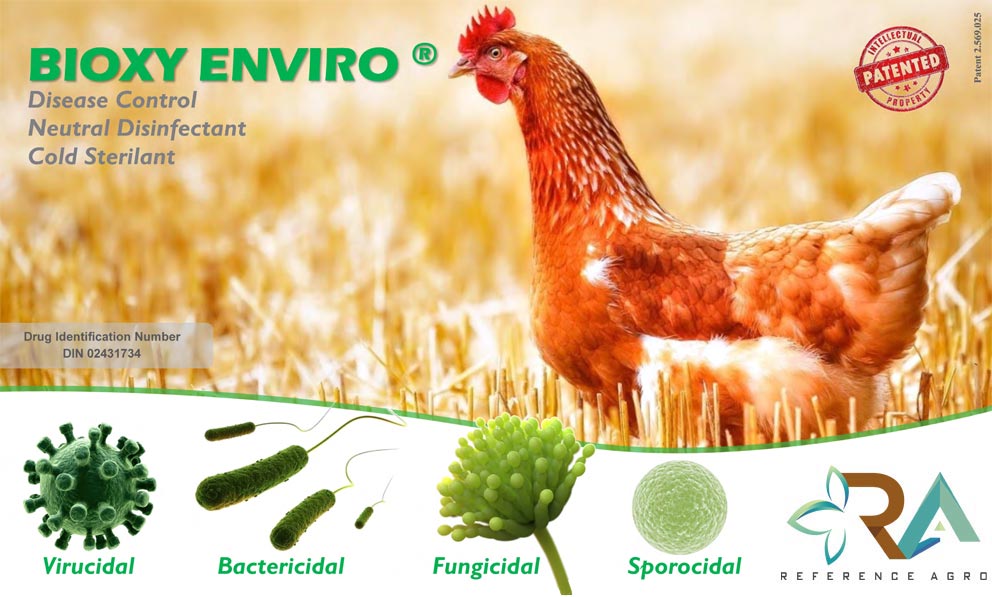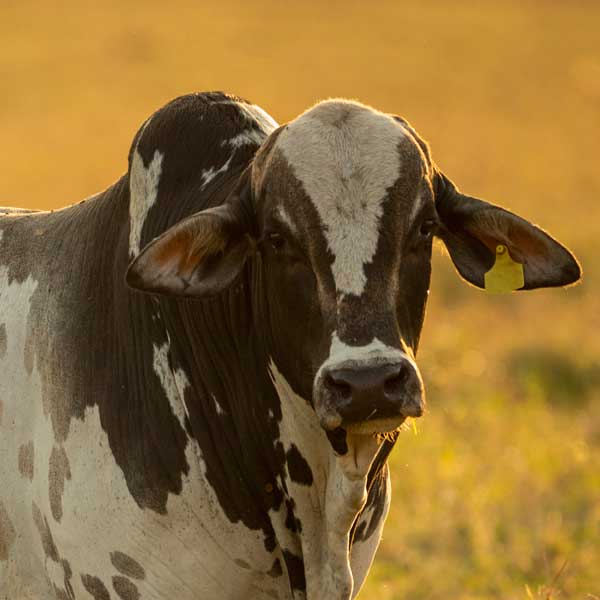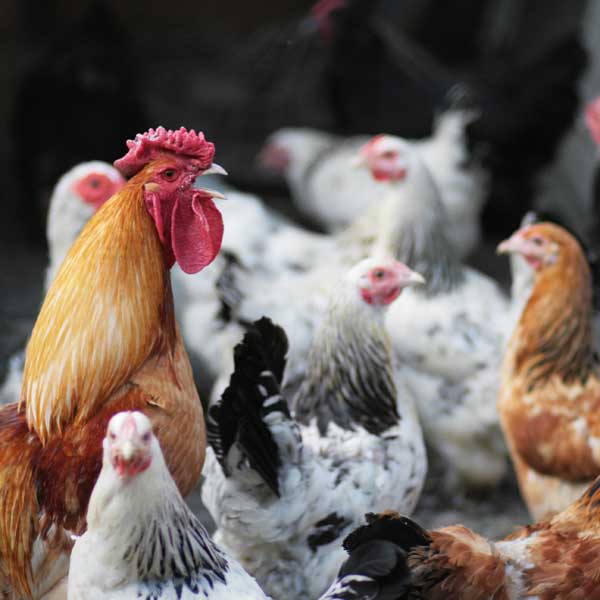
BIOXY ENVIRO POULTRY
NEUTRAL DISINFECTANT, COLD STERILIZER
Problem Silent Tsunami
Control of viral and bacterial diseases in roi always requires effort. Ensuring regulatory management, implementation and management of the vaccine and biosecurity program are efforts frequently made by farmers to eradicate viral and bacterial diseases.
Direct and indirect causes of infectious diseases:
- Bacteria
- Viruses
- Mushrooms
- Chemicals
Bacteria
TOP 10 BACTERIAYEL DISEASE
- Botulism
- Gangrenous Dermatitis
- Necrotic Enteritis
- E. Coli
- Fowl Cholera
- Pasteurella
- Salmonella
- Fowl Typho and Paratyphoid
- Staphylococcus
- Streptococcus
Antibiotic resistance has become one of the biggest threats to global health.
TOP 10 AMR POULTRY PATHOGENS
- Escherichia coli
- Salmonella Pullorum / Gallinarum
- Clostridium perfringens
- Mycoplasma spp.
- Pasteurella multocida
- Avibacterium paragallinarum
- Gallibacterium anatis
- Bordetella avium
- Riemerella anatipestifer.
Viruses
TOP VIRAL DISEASES (NOT RESPIRATORY)
- Avian Encephalomyelitis
- Avian Leucosis – Marek’s Disease
- Avian Pox
- Adenovirus
- Infectious Bursal Disease (IBD)
- Inclusion Body Hepatitis
- Coronavirus
TOP VIRAL DISEASES (RESPIRATORY AND VIRAL-LIKE)
- 1-New Castle Disease
- Infectious Bronchitis
- Laryngotracheitis
- Avian Influenza
- Paramyxovirus
- Mycoplasma (M, G and S) (Viral Like Respiratory Disease)
FUNGUS
TOP FUNGUS DISEASES
- Aspergillus
- Candida
- Fusarium
Chemicals
In addition to all the above-mentioned causes of infectious diseases, indirect causes associated with chemicals used in biosecurity should not be forgotten. Great difficulties are encountered by disinfectants:
- Ineffective due to outdated technology
- Ineffective due to bacterial resistance.
- Toxic and carcinogenic technology such as glutaraldehyde.
- Cannot increase concentration due to harsh and abrasive technologies
- It cannot be applied on birds.
BIOXY ENVIRO ®
BIOXY ENVIRO ® is powder, when dissolved in water it forms three active disinfectants at neutral pH making it safe for users; Peroxy-acetic agent, hydrogen peroxide and two quaternary chains of the fourth generation.
BIOXY ENVIRO ® is a set surface disinfectant used in agricultural areas including the food and beverage industry, animal farms and barns. The powder degrades quickly and leaves no residue in the environment, in addition, there is no microbial resistance.
BIOXY ENVIRO ® is a champion against a broad spectrum of microorganisms. It is also safe and effective in the presence of biofilm, dirt and other debris.
BIOXY ENVIRO ® can replace glutaraldehyde, aldehyde and chlorine based toxic and corrosive products with its environmentally friendly and safe formula.
BIOXY ENVIRO ® can be used on all hard surfaces without damaging it. It is virtually odorless, proving to be an excellent solution for user safety as well as for all equipment.
Features & Benefits
|
|
Usage Instructions
FARMS
I. PROTECTION
Use Bioxy Enviro ® at 0.5% concentration (5 g in 1 liter of water). This 0.5% concentration provides up to 500 ppm of active peracetic acid. Do not rinse as it is Food Contact Certified No Rinse Required. It is applied twice a week. Uyguama is done in the presence of birds. Spraying on birds.
II. DISINFECTION
Use Bioxy Enviro ® at 1% concentration (10 g in 1 liter of water). This 1% concentration provides up to 1000 ppm of active peracetic acid. It is applied twice a week and between flocks. The application is made in the presence of birds. Spraying on birds.
III. SHOCK TREATMENT
Use Bioxy Enviro ® at 2% concentration (20 g in 1 liter of water). Shock therapy can be increased to 5% depending on the severity of the infection . It is applied for 5 consecutive days until the disease is controlled. The application is made in the presence of birds. Do not spray on birds.
IV. WATER SYSTEM DISINFECTION & CONTINUOUS FEED
- For disinfection of the drinking water system, dose Bioxy Enviro ® at 1% concentration into the main tank and drain system. Wait for 15-30 minutes before emptying. It does not require rinsing. It is done once a month or when requested.
- For continuous disinfection of the drinking water system, use BIOXYENVIRO ® at a concentration of 0.1% . Apply using a dosing pump with a suitable flow rate.
V. TREATMENT USING THE ULV SYSTEM
Used in place of the hazardous glutaraldehyde fumigation in empty farm buildings and veterinary hospitals. Turn off the ventilation system during the disinfection process. Use a fogging device as part of the terminal disinfection process with the desired Bioxy Enviro ® solution. Apply at a rate of one liter of solution per 100 m3 with a particle size not exceeding 100 microns to achieve a contact time of 10 minutes with airborne microorganisms. Fogging can be done in the presence of birds. No rinsing is required after the procedure.
SLAUGHTERHOUSES
Microbiological test of the chickens from the store, campylobacter in 70% chicken, 26% salmonella, 30% Staph Aureus, 7% Campylobacter jejuni, 7% of L. monocytogenes, 8% E. Coli and revealed that it has 20% clostridium. People can become contaminated by touching chickens or their manure, according to the CDC. Birds can spread bacteria even when they appear healthy.
APPLICATION: COOLING VIA IMMERSION
Immersion Cooling Keep the pH of the immersion water between 6.0 and 6.5 and its temperature below 4.5 °C. Use high water flow and counter current flow. Use a 1% concentration of Bioxy Enviro solution in immersion water or when spraying after immersion. Doesn't require stopping. In addition, Bioxy Enviro can be used for carcass rinsing in the collection and discharge stages.
10 MINUTES KILLING STUDY
| VIRUS | SOLUTION RATIO | MICRO-ORGANISM NAME | SOLUTION RATIO | MICRO-ORGANISM NAME | SOLUTION RATIO | ||||||
| Adenovirus Pneumonia | 1 in 100 parts | Rift Valley fever | 1 in 500 parts | Staphylococcus aureus | 1 in 150 parts | ||||||
| African Horse Sickness Virus | 1 in 200 parts | Simian Virus (SV40 Virus) | 1 in 100 parts | Staphylococcus epidermidis | 1 in 150 parts | ||||||
| African Swine Fever Virus | 1 in 100 parts | Swine Influenza Virus | 1 in 100 parts | Streptococcus equi (Strangles) | 1 in 150 parts | ||||||
| Avian Influenza Virus H7N1 – H5N1 | 1 in 400 parts | Swine Vesicular Disease Virus | 1 in 100 parts | Streptococcus pyogenes | 1 in 150 parts | ||||||
| Avian Laryngotracheitis Viruses | 1 in 100 parts | Marek’s Disease Virus | 1 in 250 parts | Streptococcus suis | 1 in 150 parts | ||||||
| Avian reovirus | 1 in 150 parts | Mouse Parvovirus | 1 in 100 parts | Taylorella equigenitalis | 1 in 500 parts | ||||||
| Bovine Adenoviruses Type 4 | 1 in 250 parts | Myeloid leucosis | 1 in 200 parts | Treponema hyodysenteriae | 1 in 150 parts | ||||||
| Bovine Polyoma Virus | 1 in 100 parts | Newcastle Disease Virus | 1 in 300 parts | FUNGUS | SOLUTION RATIO | ||||||
| Bovine Pseudocopox Virus | 1 in 500 parts | PCVS Virus (PMWS) | 1 in 100 parts | Aspergillus fumigatus | 1 in 150 parts | ||||||
| Bovine Viral Diarrrhea Virus. | 1 in 500 parts | Porcine Parvovirus | 1 in 100 parts | Aspergillus niger | 1 in 150 parts | ||||||
| Calf Rotavirus | 1 in 100 parts | Porcine Reproductive and Respiratory | 1 in 100 parts | Candida albicans | 1 in 150 parts | ||||||
| Canine Adenovirus (Canine Hepatitis) | 1 in 250 parts | Poultry Enteritis (PEMS) | 1 in 100 parts | Fusarium moniliforme | 1 in 150 parts | ||||||
| Canine Coronavirus | 1 in 100 parts | Syndrome Virus (PRRS) | 1 in 100 parts | Microsporum canis | 1 in 300 parts | ||||||
| Canine Parainfluenza Virus | 1 in 100 parts | Pseudorabies Virus (Aujesky’s Disease) | 1 in 100 parts | Malassezia pachydermatis | 1 in 150 parts | ||||||
| Canine Parvovirus | 1 in 100 parts | Rabies | 1 in 100 parts | Trichophyton mentagrophytes | 1 in 300 parts | ||||||
| Chicken Anemia Virus | 1 in 250 parts | Rotaviral Diarrhea Virus | 1 in 100 parts | Trichophyton spp. (Mud Fever) | 1 in 300 parts | ||||||
| Cholera | 1 in 100 parts | Transmissible Gastroenteritis Virus (TGE) | 1 in 100 parts | Trichophyton spp. (Ringworm) | 1 in 300 parts | ||||||
| Coital Exantherma Virus | 1 in 100 parts | Turkey Herpes Virus | 1 in 100 parts | Trichophyton mentagrophytes | 1 in 300 parts | ||||||
| Distemper Virus | 1 in 100 parts | Turkey Rhinotracheitis Virus | 1 in 250 parts | Trichophyton spp. (Mud Fever) | 1 in 300 parts | ||||||
| Duck Adenovirus | 1 in 100 parts | TRT | 1 in 250 parts | Trichophyton spp. (Ringworm) | 1 in 300 parts | ||||||
| Duck Enteritis Virus | 1 in 750 parts | Vesicular Stomatitis | 1 in 500 parts | Treponema hyodysenteriae | 1 in 150 parts | ||||||
| Egg Drop Syndrome Adenovirus | 11 in 200 parts | BACTERIA | SOLUTION RATIO | Aspergillus fumigatus | 1 in 150 parts | ||||||
| Equine Arteritis Virus | 1 in 500 parts | Actinobacillus pleuropneumoniae | 1 in 250 parts | Aspergillus niger | 1 in 150 parts | ||||||
| Equine Contagious Abortion Virus | 1 in 500 parts | Bordetella avium | 1 in 150 parts | Candida albicans | 1 in 150 parts | ||||||
| Equine Herpes Virus (Type 1) | 1 in 250 parts | Bordetella bronchiseptica | 1 in 200 parts | Fusarium moniliforme | 1 in 150 parts | ||||||
| Equine Herpes Virus (Type 3) | 1 in 200 parts | Bacillus Amyloliquefaciens cereus | 1 in 150 parts | ||||||||
| Equine Infectious Anemia Virus | 1 in 500 parts | Brucella abortus | 1 in 150 parts | ||||||||
| (Swamp Fever) | 1 in 100 parts | Campylobacter jejuni | 1 in 150 parts | ||||||||
| Equine Influenza Virus (Type A) | 1 in 100 parts | Campylobacter Coli | 1 in 150 parts | ||||||||
| Equine Influenza Virus (The Cough) | 1 in 100 parts | Campylobacter Pyloridis | 1 in 150 parts | ||||||||
| Equine Papillomatosis Virus | 1 in 100 parts | Campylobacter Psittaci | 1 in 150 parts | ||||||||
| Feline Calicivirus | 1 in 100 parts | Clostridium perfringens | 1 in 150 parts | ||||||||
| Feline Herpes Virus | 1 in 200 parts | Dermatophilus congolensis | 1 in 150 parts | ||||||||
| Feline Infectious Peritonitis Virus | 1 in 100 parts | Enterobacter Cloacae | 1 in 250 parts | ||||||||
| Feline Panleukopenia Virus | 1 in 250 parts | Escherichia coli | 1 in 150 parts | ||||||||
| Feline Parvovirus | 1 in 100 parts | Klebsiella pneumonia | 1 in 250 parts | ||||||||
| FMD | 1 in 100 parts | Klebsiella Oxytoca | 1 in 150 parts | ||||||||
| Feline Rhinotracheitis Virus | 1 in 100 parts | Listeria Monocytogenes | 1 in 150 parts | ||||||||
| Foot and Mouth Disease Virus | 1 in 100 parts | Mycoplasma gallisepticum | 1 in 150 parts | ||||||||
| Fowl pox | 1 in 150 parts | Mycoplasma hyopneumoniae | 1 in 1000 parts | ||||||||
| Helicobacter pylori | 1 in 100 parts | Moraxella bovis (Pink Eye) | 1 in 150 parts | ||||||||
| Hog Cholera Virus | 1 in 100 parts | Mycoplasma gallisepticum | 1 in 150 parts | ||||||||
| Infectious Bronchitis Virus | 1 in 150 parts | Mycoplasma hyopneumonia | 1 in 150 parts | ||||||||
| Infectious Bursal Disease Virus | 1 in 300 parts | Mycoplasma mycoides | 1 in 250 parts | ||||||||
| Infectious Canine Hepatitis Virus | 1 in 200 parts | Pasteurella multocida | 1 in 200 parts | ||||||||
| Infective Bovine Rhinotracheitis Virus | 1 in 200 parts | Pseudomonas aeruginosa | 1 in 150 parts | ||||||||
| Infectious laryngotracheitis (ILT) | 1 in 150 parts | Pseudomonas vulgaris | 1 in 150 parts | ||||||||
| Leptospira Canicola Virus | 1 in 100 parts | Salmonella enterica | 1 in 150 parts | ||||||||
| Lassa Fever | 1 in 100 parts | Salmonella typhimurium | 1 in 250 parts | ||||||||
| Maedi-Visna Virus | 1 in 100 parts | Shigella sonnei | 1 in 150 parts | ||||||||




